Samsung’s V-NAND: Hitting the Reset Button on NAND Scaling
by Anand Lal Shimpi on August 21, 2013 2:50 AM EST
SSD pricing has come down tremendously since Intel’s X25-M hit the scene in 2008. Back then we were talking about 80GB for around $600, while today Micron and Samsung will sell you a 1TB SSD for the same price. Moore’s Law drove this scaling in capacity. Smaller transistors paved the way for higher density NAND in the same die area, and increasing volumes helped to keep the fabs full.
Although scaling transistor size helped address the cost-per-bit problem, it created a new one: decreasing endurance and performance. Just looking at what’s happened to IMFT NAND over the past few generations gives us an idea of what we’re dealing with:
| Micron NAND Evolution | ||||||||||||
| 50nm | 34nm | 25nm | 20nm | 20nm | 16nm | |||||||
| Single Die Max Capacity | 16Gbit | 32Gbit | 64Gbit | 64Gbit | 128Gbit | 128Gbit | ||||||
| Program Page (typical) | 900 µs | 1200 µs | 1300 µs | 1300 µs | 1600 µs | ? | ||||||
| Rated Program/Erase Cycles | 10000 | 5000 | 3000 | 3000 | 3000 | ~3000 | ||||||
Both endurance and performance trend downwards. Modern SSDs deal with the endurance problem by implementing sophisticated error checking/correction, and the performance problem is masked by exploiting parallelism as best as possible.
The root cause is basic physics. To store 2 bits per cell in present day MLC NAND, we’re talking about counting a couple dozen electrons. Go to 3 bits per cell (TLC NAND) and the difference between levels shrinks further. Scale down to 14/15/16nm NAND and everything gets more difficult. We’re heading towards a situation where the difference between levels in a NAND cell are a matter of a handful of electrons.
Measuring such subtle differences in stored charge is difficult, especially when NAND cells continue to shrink and are packed very tightly together. Interference between the cells becomes a much bigger concern below 20nm. Back at 50nm these sorts of issues were easy to mitigate with decent controllers and good quality NAND. Now we’re seeing more sophisticated ECC and DSP-like work being done by the controller in order to get accurate data in/out of the drive.
Scaling of traditional NAND via smaller manufacturing processes will come to an end. I’ve heard estimates saying we’ll see one or two more shrinks before it becomes unfeasible to scale cell size any further. The question then becomes: what’s next?
Last week Samsung gave their answer: V-NAND, a 3D NAND leveraging charge trap flash technology.
How it Works
Rather than increasing density by shrinking cell size, Samsung’s V-NAND takes a few steps back in process technology and instead stacks multiple layers of NAND cells on top of one another.
The change isn’t so simple. I’ve used the floating gate transistor diagram in many of our big SSD articles in the past, but that cell design doesn’t apply to V-NAND. In the floating gate MOSFET, electrons are stored on the gate itself - a conductor. Defects in the transistor (e.g. from repeated writes) can cause a short between the gate and channel, depleting any stored charge in the gate. If the gate is no longer able to reliably store a charge, then the cell is bad and can no longer be written to. Ultimately this is what happens when you wear out an SSD.
With V-NAND, Samsung abandons the floating gate MOSFET and instead turns to its own Charge Trap Flash (CTF) design. An individual cell looks quite similar, but charge is stored on an insulating layer instead of a conductor. This seemingly small change comes with a bunch of benefits, including higher endurance and a reduction in overall cell size. That’s just part of the story though.
V-NAND takes this CTF architecture, and reorganizes it into a non-planar design. The insulator surrounds the channel, and the control gate surrounds it. The 3D/non-planar design increases the physical area that can hold a charge, which in turn improves performance and endurance.
The final piece of the V-NAND puzzle is to stack multiple layers of these 3D CTF NAND cells. Since Samsung is building density vertically, there’s not as much pressure to shrink transistor sizes. With relaxed planar space constraints, Samsung turned to an older manufacturing process (30nm class, so somewhere between 30 and 39nm) as the basis of V-NAND.
By going with an older process, Samsung inherently benefits from higher endurance and interference between cells is less of an issue. Combine those benefits with the inherent endurance advantages of CTF and you end up with a very reliable solution. Whereas present day 19/20nm 2-bit-per-cell MLC NAND is good for around 3000 program/erase cycles, Samsung’s 30nm-class V-NAND could withstand over 10x that (35K p/e cycles).
The move to an older process node doesn’t even come at a reduction in density thanks to just how high Samsung can stack its V-NAND. In its announcement last week, Samsung introduced a first generation 128Gbit MLC V-NAND solution with 24 layers. The 128Gbit device delivers 2x the density in the same physical space as a 19/20nm 64Gbit device, or roughly equivalent density to a traditional 128Gbit planar device at 15nm - the obvious benefit being better endurance, and performance.
Since we’re dealing with physically larger NAND cells that are also less susceptible to certain types of interference, program times are lower - meaning that performance is higher. With fewer retries required for all reads/writes, overall power consumption can be lower as well. At the end of the day, it’s just a better solution.
Samsung went one step further and announced that it was sampling an enterprise SSD built around V-NAND to key customers. Since V-NAND is presently only available in a 128Gbit density, capacities aren't anything earth shattering but I suspect that'll change soon enough. It’s too early to talk about pricing and availability unfortunately.
V-NAND is the future for Samsung. We’ll see V-NAND in appear in enterprise, client and even mobile (phones/tablets). There will likely be a period of overlap as Samsung transitions to V-NAND, but expect to see that transition begin next year across multiple markets.
A 128Gbit device is nice, but that’s not the end of the road. Samsung is predicting it’ll be able to build a 1Tb device by 2017, showcasing just how much scaling it can get out of 3D NAND. Samsung could theoretically also move to a smaller process node to further increase density, although ultimately that will run into the same limitations we’re facing today with traditional, planar NAND. The initial design only stores two bits per cell, but if need be Samsung could also move to a TLC V-NAND.
What about the rest of the present day NAND players? I suspect those that don’t move to CTF and/or 3D NAND will instead have their sights set on a bigger departure from NAND: some form of resistive RAM. The potential performance gains there are even higher, and you can also deploy a vertically stacked solution to gain density.
The good news is that it looks like we’re going to have some great options that will enable continued improvements in SSD density, cost and performance.


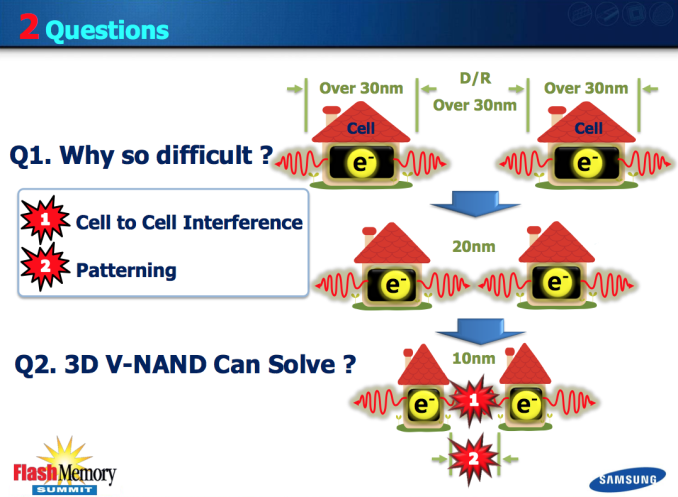
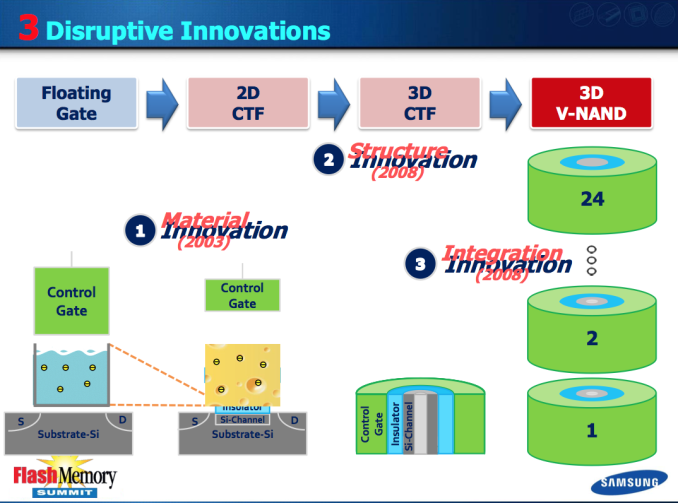
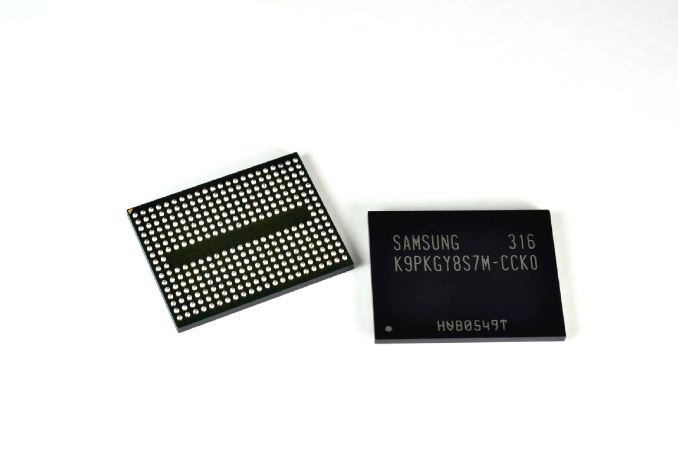
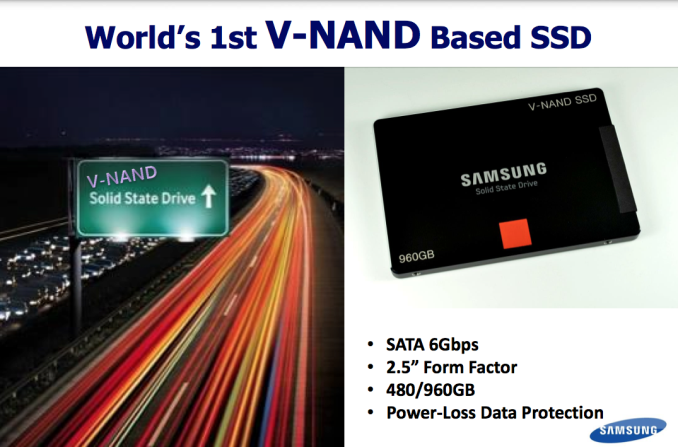
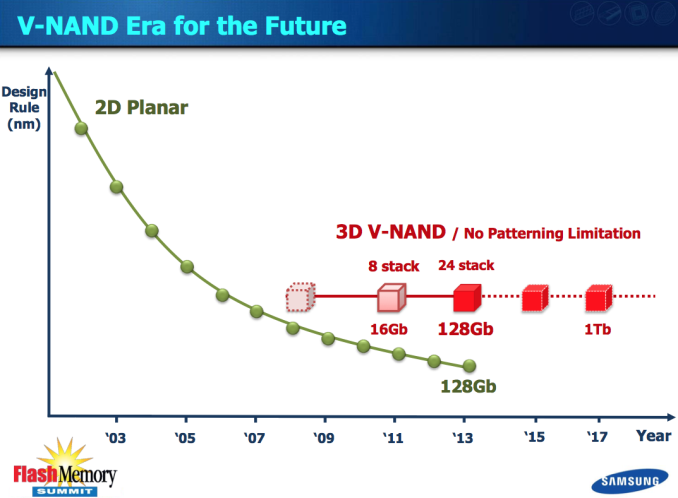








44 Comments
View All Comments
Joel Kleppinger - Wednesday, August 21, 2013 - link
Then you have to have another bit to store the value of that bit... and what's the point?Fujikoma - Wednesday, August 21, 2013 - link
You'd use more addressing bits to point to that bit or you'd wear the SSD faster by analyzing it to overlay the data to match up with that bit.chaos215bar2 - Wednesday, August 21, 2013 - link
What you're proposing amounts to not marking a block as bad immediately if a write fails, hoping that a future write will succeed anyway (possibly because it writes zeros to all the bad cells). I could easily imagine some controllers doing this already at the cost of a little performance, but once you have a few bad cells in a block, the chances of finding data that can actually be written to the block quickly get so low it doesn't seem worth trying.An alternative scheme would be to use error correction that could detect and correct some number of bad bits (say, n) and to allow writes up until the block has a smaller number of bad bits (maybe n/2). That actually seems like a better idea, assuming you can make n large enough.
Azurael - Wednesday, August 21, 2013 - link
Erm... Samsung eMMC... Every time they fix a previous fatal bug, they introduce a new one...http://wiki.cyanogenmod.org/w/EMMC_Bugs
I'm assuming the NAND itself is probably okay and they've just got no clue how to make a working controller, but personally I avoid anything I know to contain Sammy flash...
p1esk - Wednesday, August 21, 2013 - link
It would be interesting to know how they implemented interconnect wires between all those layers. More wires to drive = higher current needed = more power dissipation. Also, more wires = more capacitance = higher delays = lower read/write performance.Chanel wrapping charge trap/gate is a good move, similar to FinFET idea.
garadante - Wednesday, August 21, 2013 - link
Hmm... Does anyone know if this V-NAND stacking is stacking individual wafers atop each other with vertical interconnects running down, or are they somehow managing to fab it like this? I'm assuming it's the first, where they're stacking individual wafers. While that seems good and great... if that's the case, that doesn't really increase the number of chips you can get off a single wafer. Now you're using 24 chips instead of 1. Seems like that wouldn't drive costs down without massively increasing production? Someone correct me if I'm wrong, but if I'm right and this is wafer stacking, can someone please explain how it's cheaper? Wafer costs are pretty much everything.strappe - Wednesday, August 21, 2013 - link
This is a single wafer. In a conventional planar chip, all the channels of the every transistor lie side-by-side just below the top surface of the silicon wafer. Next, gates are formed directly on top of the wafer. Finally, alternating layers of insulation and metal are deposited to connect the transistors together; the insulation allows the metal wires to cross without short-circuiting. (A complex device like a microprocessor will often have over a dozen metal layers.)Instead of new layers of metal, Samsung is laying down new transistors. NAND flash was a big breakthrough (over the older NOR flash) by series-connecting all the transistors in a long string so they didn't have to be connected by metal (think of a Christmas light string). Samsung has flipped the string to make each one vertical.
From the drawings, the channels of each device in the string form one long continuous column. Distinct devices are created by insulating the other FET elements (gate and charge storage) in each layer from the one above and below (you can see this shown in the video).
Since each layer is the same, they all use the same masks, but the overall throughput has to be a lot lower because each wafer has to be processed many more times (I'd guess a minimum of three deposition steps to form each layer). So wafer costs will be higher. Figuring out how to keep all those layers consistent and aligned precisely (so that those columns really are vertical) must have been an enormous challenge.
garadante - Wednesday, August 21, 2013 - link
So either way, costs are going to increase with this. Density increases, but output decreases. I wonder how long it will be before we this in mass market storage devices at lower prices than traditional NAND.pdjblum - Wednesday, August 21, 2013 - link
I for one totally favor larger transistor size and much longer endurance. And I rather rely on robust physical properties than error checking and manipulation. I don't want to have to worry about my data in five years, or even ten. Go samsung! Quality over quantity any day for me.MxxCon - Wednesday, August 21, 2013 - link
So what are the drawbacks of this technology?This article talks about all the great benefits it'll bring, but what are its disadvantages?